TERC Blog
Online or In-Person: The Power of Collaborative Conversations
Twenty-first century professional development means choices, flexibility, and judicious use of technology. The Investigations Center for Curriculum and Professional Development at TERC, home to the Investigations curriculum, provides a variety of professional development resources and workshops for teachers, coaches, and administrators, with an eye towards supporting math teaching and learning, using technology as a tool to reach our diverse audience.Investigations 3 in the K-5 Classroom can be taken as a four-day in person workshop or as a 7-week online course. Both experiences focus on computational fluency, 2-D geometry and measurement, models and representations for fractions, and more. Both experiences are active and experiential with participants engaging in mathematics, examining student work and video, and considering how the Investigations 3 (INV3) curriculum supports mathematics teaching and learning. Both experiences emphasize learning with and from fellow participants.
Whether online or in-person, the INV3 professional development team knows the power of collaborative conversation to support learning. In the blogposts on the following pages, Investigations' staff share their reflections on how being in the room together — whether physically in a classroom, or virtually in the online space of a forum — generates conversations that produce new learning. These posts also demonstrate the commitment of the Investigations' staff to their own continual learning and to reflecting on the best tools and strategies for engaging and supporting adult learners.
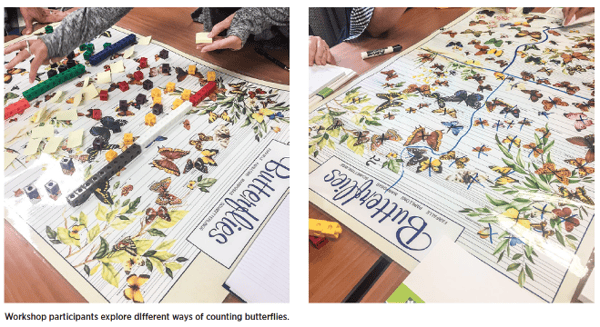
Counting is More Than 1, 2, 3: Engaging Adults in K-2 Mathematics
by Karen Economopoulos
How do we engage adult learners in the seemingly simple yet complex mathematical ideas of the primary grades? Playing Counters in a Cup or solving a How Many of Each? problem aren't exactly engaging math tasks for adults. Though teachers might examine the mathematical focus of each task, think about what questions they might ask to assess understanding, and consider how they might support or extend the targeted math ideas, how can engaging in these K-2 level math tasks help teachers understand how complex they are from the viewpoint of young students?
A few weeks ago, I attended an Investigations 3 in the K-5 Classroom workshop. I observed a group of K-5 teachers and coaches immersed in a counting task, sharing their strategies, and then connecting how their experience brought out the complexities of counting. As I watched, I was once again reminded of why How Many Butterflies? is one of my touchstone tasks for engaging adult learners in the mathematics that is central to the primary grades.
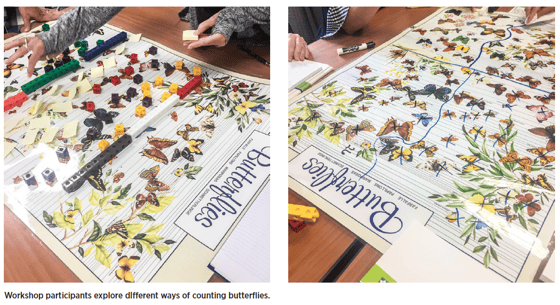
Participants are instantly drawn to the large, laminated "Butterflies" poster as they find a butterfly they recognize or point out ones that are especially unusual. The display is interesting in that there is variability of color, size, pattern and orientation. Very quickly, a comment of "Wow I never knew there were so many types of butterflies!" is followed by the question of "I wonder how many there are?" and the investigation begins.
There are several factors that make this counting task challenging: the butterflies are randomly arranged on the poster so counting them in an organized manner requires a plan. The butterflies are stationary. You can't pick them up and move them as you count or organize them into convenient sized-groups, so determining how to keep track of what has been counted and what's left to count becomes a decision.
Since people are working in small groups, negotiating a plan of action becomes part of the task and once the plan is enacted, it is not unusual to hear comments such as "Could you count more quietly, I'm getting distracted" or "No, I think that butterfly is on my side of the poster and I counted it already." Inevitably someone catches wind of an interesting counting strategy being employed by another group and convinces their group to abandon their original idea and shift to a different strategy. Rarely do all groups arrive at the same answer. In fact, it is the result of different answers that spurs people into recounting and double-checking their work. These comments and experiences are remarkably similar to what you might see or hear when watching K-2 students engaged in similar work.
The debrief of the task brings out all of the complexities about counting that are in fact central mathematical ideas in the primary grades. These ideas include knowing the rote counting sequence and assigning one number to each object, keeping track of what has and has not yet been counted, and knowing that if you count smaller sub-groups and add those groups together, the total represents the number of butterflies on the poster.
Primary teachers often reflect on how adults' knowledge about counting and quantity influences their experience, citing things like "If we all have the same poster then we should all get the same number" and "If our group counts and then double-checks, the number should be the same" as being obvious to adults or even to older students. These ideas however, are not obvious to our youngest learners and are important parts of the mathematics they are working on. Inevitably upper grade teachers talk about their own "ahas" about the complexities of counting and reflect on how they can see aspects of these same ideas about counting by 1s and groups coming into play in the later grades in multiplication and work with fractions and decimals.
I am always searching for and playing around with K-2 games and activities that can be adjusted (e.g., adapting a material) or extended (e.g., changing the question) in such a way that the underlying math investigation shifts from being just right for a K-2 student to engaging for an adult. Part of the engagement is that the task is interesting and challenging, but equally important is that it offers teachers a new look at the math they teach and reaffirms the importance and complexities of even the "simplest" mathematics.
The Power of Discussion Forums for Online Professional Development
by Annie Sussman
My colleague, Arusha Hollister, and I facilitate the Implementing Investigations 3 (II3) online course. The II3 course discussion forum, which essentially functions as an online community, is one of the most interesting and challenging aspects of the course from the standpoint of the facilitator. During the 7-week course, participants log in several times per week to reflect on, and ask questions about, the activities and readings in the weekly sessions. For each session, we pose a question for everyone to consider that highlights the key mathematical ideas in that session.
Creating an online forum in which everyone can connect with colleagues and engage in meaningful conversation requires lots of careful planning. Over the past year, Arusha and I have been thinking together about the factors that contribute to the development of the forum. Here are some key takeaways from our work. Ask questions that encourage depth over breadth We have found that questions that ask participants to think very broadly about a mathematical topic often encourage people to summarize information, which does not promote engaging conversation, so we've switched to questions that encourage participants to go deep. For example, we recently replaced the question, "What does it mean to be computationally fluent?" — which appeared at the end of the session about addition and subtraction in the early grades — to "What do you see as the key elements of the work students do in the early grades with addition and subtraction?" The former question tended to encourage a lot of summaries about the elements of computational fluency, while the latter has sparked conversation about a range of topics including the importance of flexibility in problem solving, mathematical language, the Standards for Mathematical Practice, and much more.
Create space to discuss the ideas and questions that feel most relevant to participants
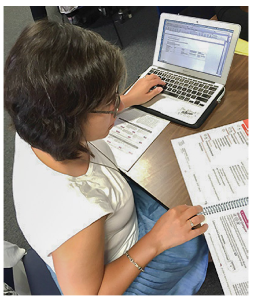
The best conversations arise when people feel that they can use the forum as a tool to extend their learning rather than as a place where they must compose the "correct" answer to a specific question. Over time, we have come to describe the forum as a place for people to write about aspects of their learning, or ideas or questions that are coming up for them. While we do pose a question to consider, we now emphasize that this is meant as a jumping off point.
Help everyone make connections between new learning and classroom practice
Meaningful professional development happens when there are multiple opportunities to connect and enact new learning in one's professional work. We encourage participants to offer specific examples of the ways in which they plan to change their teaching practice in response to new ideas they have encountered in the course. Being specific helps participants really articulate how a new idea can be put into action. For example, one participant wrote the following in response to the session on multiplication and division:
"I expanded my knowledge regarding how helpful arrays are for developing meaning and solving multiplication problems. As a second-grade teacher, understanding the progression of this tool through the upper grades is helpful. Going forward, I will aim to be more purposeful in helping students notice equal groups and identify and describe the patterns they notice."
Know when to respond as a facilitator
This is perhaps the most challenging aspect of facilitation. It feels important to give participants space to connect with each other and so we do try to limit our involvement on the forum. Sometimes, however, a response from us is warranted, particularly when a specific question about the curriculum comes up. For example, a question about how students are instructed to fill a ten-frame at the beginning of kindergarten is something our staff can answer quickly and unequivocally.
Looking Ahead to Continued Learning
While each new iteration of the II3 course presents new opportunities to learn more about online course facilitation and the teaching and learning of mathematics, the power of the discussion forum remains central.
Download Hands On! Spring 2019
For free TERC math resources, including At-Home Investigations Resources, click here.

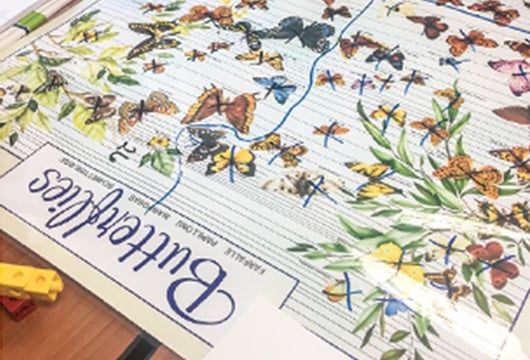




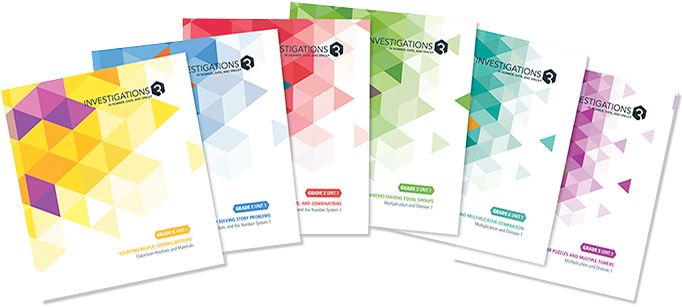

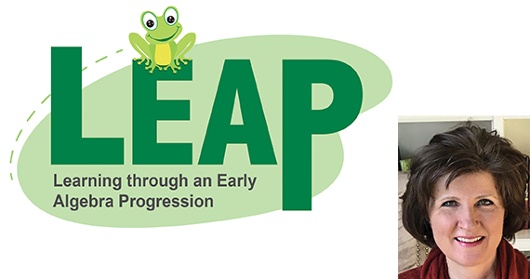
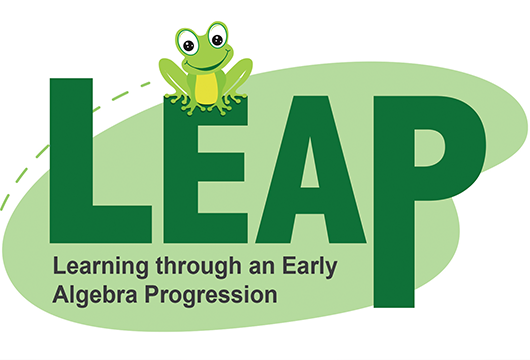
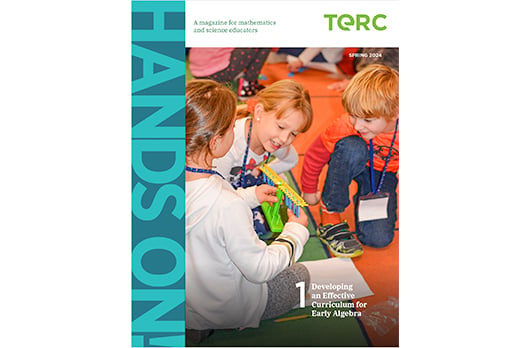

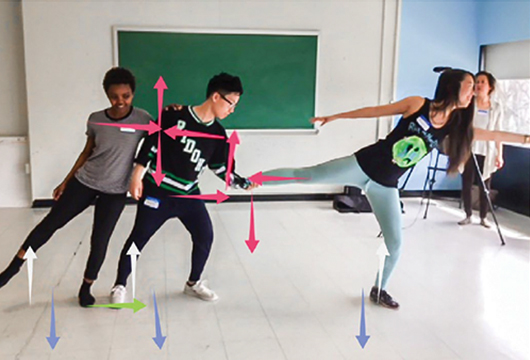
-1.png)